Variation in milk and its relationship with management in crossbred cattle
Variation in milk composition and its relationship with physiological states and management in crossbred cattle under tropical conditions
Published: November 23, 2009
By: Anila Mushtaq and Muhammad Subhan Qureshi
ABSTRACT: Milk is the product of various biological reactions occurring inside the animal's body coupled with external environmental factors.The unfavorable subtropical conditions are not only affecting the quantity of milk but also its quality. The present study was designed to investigate the effect of physiological states and management on milk composition and yield in crossbred cattle. A total of 58 crossbred cows were selected from a large state farm at Peshawar, Pakistan. The animals were divided into younger, mature and older. Lactation was classified as early, mid and late; while pregnancy status as first, second and third trimester. Two types, each of green fodders and concentrates were provided. Body condition score (BCS), milk yield and composition were recorded weekly. The study continued from March to May, 2008. Pregnancy and lactation stage significantly affected the milk yield (P<0.05) but not its composition. The combined feeding of whole crop maize (WCM) and Egyptian clovers (EC) yielded higher concentration of fats and solids not fats than the EC alone. Milk pH was significantly higher with intake of EC. The concentrate mixture having cotton seed cake (CC), wheat bran (WB) and maize oil cake (MC) has supported higher milk yield as well as lactose compared to the mixture composed of CC and WB. The younger and older animals showed a lower milk yield than the mature ones (9.06 ± 3.69, 11.93 ± 5.16 and 9.25 ± 2.31 liter/day, respectively). The data trend showed that fat and pH were highest in the younger and older animals while lactose revealed an opposite pattern and protein remained almost unchanged. The SNF showed almost linear upward trend with the increase in age. Lactation number was positively associated with BCS and body weight and negatively with advancing pregnancy. Body weight has significantly affected the milk yield but not the composition. Results from the present study indicates that pregnancy and lactation stage influence the milk yield and composition probably through influencing biological reactions in the body. The BCS influences milk yield probably through signaling the hypothalamus via Leptin hormone which regulates body metabolism. Under tropical conditions the lactating animals maintain higher body condition which results in lower feed intake and milk yield. In nutshell, we suggest that milk of desirable composition may be produced for special purposes through selection of appropriate physiological states coupled with special feed ingredients, in the dairy production system.
Keywords: Crossbred cattle, milk composition, physiological states, nutrition, management
INTRODUCTION
Over the years, the livestock sector has emerged as a leading sub-sector of the Agriculture in Pakistan. It contributed over 11 percent to the GDP and 52.2% of agriculture value added in addition to employment generation for 30- 35 million people in the rural areas. Livestock wealth of the country comprises 31.8 million cattle, 29.0 million buffaloes, 27.1 million sheep and 56.7 million goats (Economic Survey of Pakistan, 2007-08).
Milk is the main product of livestock farming placing the country at 3rd number in global ranking (International Dairy Federation, 2008). The cattle herds include a variety of purebred animals such as Sahiwal, Red Sindhi, Tharparker, and majority of crossbred animals. The crossbreeding of cattle has been initiated in Pakistan since last five decades, with the influx of artificial insemination. According to national livestock policy, the local cows in plain-irrigated areas are crossed with exotic Holstein-Frisian breed while the cows in hilly and dry areas are crossed with Jersey breed (Rollinson, 1978). Out of the present cattle population, 25% are crossbred animals while the remaining 75% are local cows. All the way through crossbreeding of cattle in NWFP milk production increased by 73 % and age at puberty declined by 82 % (Syed et al., 1994).
However, under the existing artificial insemination practices maintenance of 50% exotic blood is not accomplished. This leads to a decreased immunity and resistance to stressful conditions that in turn shrunk productivity. Qureshi et al. (2001) reported reproductive and productive disorders associated with crossbreeding in cattle. The average milk yield is very low compared to other countries e.g. one New Zealand cow produces as much milk as three dairy animals in Pakistan, while one American cow produces as much as seven cows in Pakistan (Garcia et al., 2003)
In addition, the unfavorable conditions are not only affecting the quantity of milk but also its quality. As milk composition is the result of various biological reactions, affected by feed intake and physiological status of animals. Physiological status, in turn, is affected by environmental parameters modulated through hypothalamus and pituitary. Dobson and Smith (2000) reported that a variety of endocrine regulatory points exist whereby, stress limits the efficiency of reproduction. Negative feedback effects appear to operate mainly at the pituitary level during transport but at the hypothalamus during hypoglycemia. The endocrine evidence showed that stressors interfere with precise timings of reproductive hormone release within the follicular phase and delay the onset of luteinizing hormone (LH) surge. The adverse seasonal, nutritional and health conditions expose the crossbred cattle to stress in the province, which lead to further decrease in productivity.
Poor availability of nutrients in amount and quality is the major constraint in developing dairy industry of Pakistan. According to Sarwar et al. (2002) in Pakistan the majority of nutrient requirements of dairy animals are met through feeding forages in contrast to advanced countries, where they are fed liberal amounts of grains.
Milk composition and quality are important characteristics that determine the nutritive value and consumer acceptability. In Pakistan the milk production, processing and marketing are still in primitive stage and needs a lot of research and development support to satisfy consumer's demand. The available milk comes from various dairy animals, in different physiological states and on various nutritional plans. Genetics, level of nutrition, parity, stage of lactation, and environmental temperatures influence milk composition and yield (Bath et al., 1985). However, evaluation of milk composition in relation to parity, lactation stage, pregnancy status, fodder and concentrates types in crossbred cattle is almost absent in literature in the study area. Therefore, the present study was designed to investigate the effect of various physiological states and management on milk composition in crossbred cattle.
MATERIALS AND METHODS
Selection and management of animals
The present study was conducted at Peshawar, in the central valley of the North-West Frontier Province (NWFP) of Pakistan, which is located at the latitude of 31-37° north and longitude of 65-74° east. A total of 58 crossbred cows were selected from a large state farm. These animals were maintained under centralized management conditions in well ventilated sheds. The animals were stall fed and chopped fodders were provided at 1000 and 1400 hrs. Concentrate ingredients were mixed with spade and were offered at milking time. The cows were milked 2 times per day by hand method at 0400 and 1600 hrs. Before milking, udder was washed by using warm water and dried with damp cloth.
During the experimental period all the animals were confined in the shed and were only taken out for water 3 to 4 times to an adjacent tank. The animals were divided into three groups on the basis of their lactation number, young (Yng- 1 to 3 lactation number), Mature (Mtr - 4 to 6) and Older (Old - 7 to 10). The selected animals were grouped into early lactation (ELct, 1 to 3 months postpartum), mid (MLct, 4 to 6) and late (LLct, 7 to 10) lactation. The pregnancy status was defined as first (1 to 3 month), second (4 to 6) and third (7 to 9) trimester. The study continued from March to May, 2008.
Feeding regime
The green fodder was fed ad libitum and the types were categorized as clovers and maize. Concentrates feeds were offered at a scale of 1.36 kg per head per day for maintenance and 1 kg per 3 kg of milk for production as per their routine practices. The types of concentrates were categorized as a combination of wheat bran and cotton seed The animals were provided standard management conditions as per the local prevailing practices. Wheat straw was fed to compensate the dry matter requirements at a scale of 2.27 kg per head per day. Changes in feeding status were recorded regarding green fodder and concentrates in initial data collection and periodical observations.
Feed sample and analysis
Representative samples of all the ingredients fed to the experimental animals were collected individually. A portion of each sample was processed for dry matter contents (AOAC, 1980) and the remaining samples were air dried at 60°C for 48 hours, ground through 1 mm sieve in a Wiley mill and stored for further analysis of ash, crude protein, crude fiber and ether extract according to (AOAC, 1980). The nitrogen free extract in the sample was determined using the following formula (Qureshi et al., 2002):
NFE = 100 - (CP % + CF % + EE % + TM %)
Where as
CP = Crude Protein (%)
EE = Ether Extract (%)
CF = Crude Fiber (%)
TM = Total Mineral (%)
Body Condition Score
Body condition score (BCS) was recorded weekly, using the method described previously (Peters and Ball, 1987). According to this method the thickness of fat over the lumber and tail head area was estimated and was assigned a score from 0 (very weak) to 5 (very fat). The BCS was categorized as: 0, spine very prominent and transverse vertebral processes feel sharp with no fat cover; 1, spine prominent and transverse process feel sharp with little fat cover; 2, transverse processes can be felt but are rounded with a thin covering of fat; 3, individual transverse vertebral processes can only be felt by firm pressure; 4, the transverse processes cannot be felt; and 5, the transverse processes covered with a thick layer of fat.
Milk yield, sampling and analysis
Milk yield was recorded (kg/day) once a week. Fresh milk samples were collected on weekly interval for twelve weeks period. Thus a total of 700 samples were collected. Milk samples (200 ml each) in bottles were transported in an ice box to dairy production laboratory in the Livestock Management Department and were stored in refrigerator for further analysis.
The milk samples were analyzed for fat, protein, lactose, total solids, solids not fat (SNF) and pH using ultrasonic milk analyzer (model Ekomilk Total Ultrasonic Milk Analyzer, Bullteh 2000, Stara Zargora, Bulgharia) according to manufacturer's instructions. Each sample of milk was analyzed in duplicate.
Milk Progesterone Assay
The milk samples were collected at weekly interval. Fat layer was removed and 100 μl of 0.1% sodium azide was added to 5 ml of milk sample, as a preservative. The samples were then stored at -20°C till analysis for progesterone assay. A 'MicroLISA Progesterone' Enzyme immunoassay kit (AMGEnix International. Inc, USA) was used for the quantitative determination of progesterone concentration in milk. Milk samples and all the reagents supplied with the kit were brought to room temperature (18-25°C) before use. Working progesterone HRP Conjugate reagent was prepared by adding 0.1 ml of concentrate solution into the diluent (1:10 dilution) and was mixed. A total of 96 coated wells were secured in the holder and were added 25 μl of standards specimens and controls into appropriate wells. After dispensing 100 μl of working progesterone HRP conjugate reagent, 50 μl of rabbit anti progesterone reagent was also added to each well and thoroughly mixed it for 30 seconds. The wells were incubated at room temperature (18-25°C) for 90 minutes. Then the micro-wells were rinsed and flicked 5 times with distilled water. Afterwards, 100 μl of TMB reagent was dispensed into each well and gently mixed for 10 seconds. Again incubation was carried out at room temperature (18-25°C) for 20 minutes. The reaction was stopped by adding 100 μl of stop solution to each well followed by shaking for 30 seconds. All the blue color changed to yellow color completely. The absorbance was read at 450 nm with a microtiter plate reader (HUMAREADER plus, cat-no 18500 P, Wiesbaden, Germany).
Data analysis
The data obtained were subjected to analysis of variance using the General Linear Model (GLM) and correlation was worked out using SPSS-10, (1999). Means were subsequently separated using Duncan's Multiple Range Test (DMRT) method as described by Hamburg (1983).
RESULTS
In this study the milk yield and composition of crossbred cows were studied at a large state farm in Peshawar. The results are discussed under two sections; the first section presents changes in milk yield and composition during various physiological states of animals including pregnancy status and lactation stage while the second section deals with management parameters comprising age, body weight, BCS, intake of green fodder and concentrates.
Effect of physiological parameters
Pregnancy
Pregnancy significantly affected the milk yield but not its composition (Table 3). Higher milk yield was recorded in the second trimester of pregnancy, afterwards in the third trimester followed by the first trimester and lowest was observed in the non pregnant animals (7.98 ± 2.72, 9.83 ± 4.72, 12.13 ± 6.00, 10.0 ± 0.00 kg/day, respectively).
Despite the fact that milk components were not affected by pregnancy but it is evident from the data that there is a linear increase in SNF with advancing pregnancy. Lactose was higher in the advanced stage and then showed a linear declining trend while protein was highest in the non pregnant animals and then decreased. Whereas, fat was highest in the initial months of pregnancy and lowest in the non pregnant animals. This study suggested that advancement in pregnancy affected the milk yield but not the composition. In addition, the non pregnant animals were also low yielders indicating hereditary relationship of the two traits.
Lactation stage
Lactation stage significantly affected the milk yield but not its components (Table 3). The highest yield was recorded in the initial months followed by late and lastly in the middle period of lactation (11.00 ± 4.58, 8.59 ± 2.72, 10.88 ± 5.78 kg/day respectively). Majority of the observations fell in early and mid lactation groups (n= 104, 107, respectively) while fewer observations (n=32) belonged to late lactation stage which reflects better genetic potential of the animals falling in this group.
Although, the composition was not significantly affected by advancing lactation, an increasing trend was noted for fat and protein levels; lactose decreased initially followed by an increase and the SNF showed a reverse pattern. As evident from figure 2, advancing lactation was positively associated with fat, opposite to milk yield. This study concludes that advancing lactation leads to reduction in milk yield and increase in milk fat and protein contents.
Effect of management parameters
Feed intake
The intake of whole crop maize and Egyptian clovers yielded higher concentration of fats and solids not fats than with the Egyptian clovers alone (Table 5, Figure 3, P < 0.05). Although, non significant, the protein and lactose also showed similar trend. But the pH was significantly higher with intake of Egyptian clovers.
Although, the milk yield was not significantly affected by the fodder types but the data trend revealed a higher milk yield in animals fed Egyptian clovers opposite to combined feeding of whole crop maize and Egyptian clover. As the green fodders contribute various substrates as a result of degradation in rumen and enzymatic digestion in the abomasum and intestines, the availability of various substrates for milk synthesis will vary with the changing fodder types. This phenomenon will lead to change in milk composition.
With the intake of concentrates lactose content was significantly affected but not the yield (Table 5, Figure 4, P < 0.05). The concentrate mixture having cotton seed cake, wheat bran and maize oil cake has supported higher milk yield as well as lactose compared to the mixture composed of cotton seed cake and wheat bran.
Age
Age affected the milk yield significantly but not the composition (Table 3). The younger and older animals showed a lower milk yield than the mature ones (9.06 ± 3.69, 11.93 ± 5.16 and 9.25 ± 2.31 kg/day, respectively). Milk increased up to 4th lactation and decreased beyond 7th (Figure 5).
Although the milk composition was not affected by increasing age, the data trend showed fat and pH being highest in the younger and older animals while lactose showed the opposite pattern and protein remained almost unchanged. The SNF showed almost linear upward trend with the increase in age. As evident from figure 6, lactation number positively affected the BCS, which may be the probable cause of increasing milk yield up to maturity of the lactating animals. This might be due to the fact that the animal mammary gland needs to fully develop according to its genetic potential during early parities. Further increase in age was not supporting increase in milk yield. In older animals the probable cause of lower milk yield may be lower feed intake due to week teeth.
Body Condition Score
The body condition score significantly and negatively affected milk progesterone level (Table 4). It slightly correlated negatively with fat, lactose, SNF (Figure 7) and milk yield while positively with protein and pH. Moreover, BCS correlated positively with body weight (Table 4) and age (Figure 6) while negatively with advancing pregnancy (Figure 1).
Body weight
Body weight has significantly affected the milk yield but not the composition (Table 4). BCS and body weight both correlated positively with age (Figure 6). It may be the probable reason of increased milk production up to maturity of animals. This means that after attaining maturity further increase in body weight and age will negatively affect lactation efficiency. Therefore, heavier weight and older animals should be culled out from the lactating herd in order to improve farm productivity.
DISCUSSION
Effect of physiological states
Pregnancy
In this study pregnancy affected the milk yield but not the composition. The milk requires various substrates for its synthesis and with the advancement of pregnancy to the third trimester more nutrient substrates are diverted towards development of fetus, placenta and fluids. Pregnancy requirements are given higher priority over milk synthesis; leaving little substrates for the later. Our concurrent study (Shah et al., 2009) reported that the increasing fertility status in dairy animals was associated with an increase in blood glucose levels from 6.0 to 9.5 mg/dl in dairy animals; while the milk lactose level decreased from 3.9 to 3.4 % at the same time (R2 = 0.81 and 0.99, respectively).
Earlier findings have attributed the post conception decline in milkyield of dairy cows to hormonal changes (Bachman et al., 1988;Akers, 2002). Our previous study (Khan et al., 2008) concluded that post conception decline in milk yield became drastic when progesterone concentration rose above 6.44 ng/ml. Similarly, the decline in yield was associated to the increase in nutritive requirements of the fetus,especially during the third part of gestation (Bell et al., 1995). In addition to the hormonal effect, yield losses might be dueto the nutritive requirements of the gravid uterus. The energy needs during pregnancy include the energy deposited in the conceptus,as well as the energy used for the conceptus metabolism and maternal tissues to support the conceptus (Freetly and Ferrell, 1998).
Our results also indicate a hereditary linkage between fertility and milk yield; reflected by coincidence of low yield with infertility. It confirms our previous finding that fertility and milk yield have genetic relationship leading to production of animals with higher yield and better fertility for selective animals (Qureshi et al., 2007). Our later study (Qureshi and Ahmad, 2008) concluded that fat-corrected milk (FCM) was 14.50±0.20, ranging from 2 to 35 kg/d; and was higher in estrus group; correlating positively with postpartum ovulation interval (r = 0.31, P < 0.01). BCS in buffaloes resuming oestrus was constantly higher than those failing to resume ovarian cyclicity.
Fulkerson (1984)and Moate and Harris (1983) also showed a positive relationship betweenmilk production and reproduction in pasture-based systems. Pryce and Veerkamp (2001) concluded thatabout 50% of the total progress in milk yield in the UK canbe ascribed to genetic improvement alone. Similarly, Hoekstra et al. (1994) showedthat after adjustment for factors, such as proportion of Holstein-Friesiangenes and genetic potential for milk yield. The improved reproductive performance was connected with higher milk yield. In addition, cows whose peak milk yield occurredearliest in lactation were more likely to have successful conceptions.
However, an antagonistic relationship between milk productionand several fertility traits was observed (Hoekstra et al., 1994; Beam and Butler, 1999;Darwash et al., 1999; Royal et al. 2000). Other studies found no relationshipbetween milk production and reproduction (Villa-Godoy et al., 1988;Raheja et al., 1989). It has been shown previously that very high milk yieldat the beginning of lactation (steep lactation curve) puts ahigh physiological stress on cows, often leading to reproductivedisorders (Madsen, 1975). Attaining peak milk yield earlierin lactation would indicate that positive energy balance isbeing achieved at an earlier stage in lactation.
It is suggested that the changing physiological states affects the utilization of metabolites in a manner that in the non fertile dairy animals the blood glucose level is maintained at the minimum which was probably consumed for maintaining higher milk lactose levels.
Lactation Stage
This study concludes that advancing lactation leads to reduction in milk yield and increase in milk fat and protein contents. The normal lactation curve for cattle and buffaloes shows a rapidly increasing trend during the initial 3 to 6 weeks after parturition and gradual decline afterwards (Bath et al., 1985); while, an inverse relationship between milk yield with its protein and fat contents exists (Banerjee, 1985). As yield increased, the percentage composition of these two elements decreased. Lactose showed a very slight decline while ash contents showed a slight increase with advancing lactation.
The findings of our study are supported by earlier report of Egbowon (2004) that milk protein and fat percentages are inversely related to milk yield. The fat and protein are at moderate level in initial stage, decreased to the minimum level during peak lactation and gradually increased towards the end of lactation. Similarly, Harris and Bachman (2008) suggested that within any given lactation, SNF content is relatively high in the first month, drops to a low in the second, than rises as lactation advances. Where as, Pavic et al. (2002) stated that in the middle and at the end of the lactation period the contents of total solids, fat, protein and pH value were higher (P < 0.01) than at the beginning.
A similar report regarding yield but dissimilar with composition was reported by Malau-Aduli et al. (2001) that breed, age, stage of lactation, season and plane of nutrition significantly affect milk yield and composition in goats. Boros (1986) observed that lactose was fairly constant over the lactation period showing no substantial changes. Huth (1995) has showed in his experiments that variation in cow milk yield can be seen in the following day after feed deficiency. Where as, greatest variation in milk yield and fat content was observed at the beginning of lactation (the first four weeks of lactation) and at the end (weeks 39 - 42) while the middle period of lactation was relatively stable (weeks 19 - 22). Our group reported a relationship of milk progesterone level with milk yield and noted a drastic decline in the yield, when the levels increased beyond 6.4 ng/ml (Khan et al., 2008).
Effect of management
Feeding management
Fat and SNF was significantly affected by fodders intake in this study. As maize cob is basically the energy source but when fed as whole crop along with stem and leaves it becomes a fiber source besides energy which leads towards more appropriate acetate: propionate ratio, in turn leading towards higher fat and SNF than Egyptian clover when fed as sole crop. Egyptian clover is a leguminous crop and a sole source of protein usually deficient in carbohydrates which negatively affected the microbial population as well as microbial protein synthesis which in turn disturbed the acetate production leading to reduced milk fat synthesis. In the whole crop maize the fiber contents were higher than the Egyptian clover causing natural buffering and an increased acetate and propionate ratio which in turn enhanced milk fat content.
Our study confirms an earlier report (Perry and Stalling, 1993) that milk fat concentration increased from 3.36% to 3.69% by increasing fiber from 17% to 25%. In their study milk protein concentration showed no change but in our case the high fibers from whole maize fodder was also supplemented with protein from Egyptian clover which resulted in better fat, protein and SNF contents in the milk.
According to Harris and Bachman (2003) nutrition of the cow has visible effect on milk composition, specifically the fat content of milk. The solids-not-fat content of milk also varies with changes in the ration but to a lesser extent than the fat content. Feeding extra energy to high producing cows may improve the SNF by about 0.2 percentage units. While reducing the energy-fed to high-producing cows below requirements may decrease SNF as much as 0.2 - 0.5 percentage units. Forage quality and quantity affect milk SNF. Increasing roughage intake usually reduces SNF and milk production. The decline is mainly due to reduction in energy or dry matter intake. Improving energy or dry matter intake will restore the SNF to normal. With intake of good quality hay SNF increases, but with poor quality both intake and SNF will decrease. Adding more roughage to the ration has negligible effect on SNF. However, a minimum amount of roughage is needed for normal milk fat percent and health maintenance of the cow.
Lactation number
In this study a significant effect of lactation number on milk yield was observed. This may partly be due to increase in body weight and size, which results in larger mass of digestive system and mammary glands for synthesis of milk. In addition, the effects of recurring pregnancy and lactations also supported higher yield of cows. This is evident from the linear upward trend of both the body condition and weight with the increasing lactation number in the experimental animals.
Our study confirms the previous reports that mature cows produce about 25% more milk than 2 year old heifers. The increase in milk yield with the increasing age was partially (5 %) attributed to higher body weight, whereas the remaining 20% is the result of increased development of the udder during recurring pregnancies (Bath et al., 1985). Similarly, Sardar et al. (1997) and Afzal et al. (2007) also reported significant effect of parity on milk production and found more milk in cows with greater parities than those with lesser parities. Similarly, Bajwa et al. (2004); Javed (1999); Tahir et al. (1989); Deshpande and Sakhare (1984) and Lee and Kim (2006) reported increase in milk yield towards 5th parity and decline thereafter.
On the other hand non significant effect of lactation number on milk composition was observed. That may be ascribed to the uniform management practices of the animals during the period of study. Milk composition is the result of the traffic of substrates from the blood circulation to the memory tissues. This traffic is controlled by various factors related to, homeostasis, physiological and genetic status of the animal, which in turn differs at various physiological states (Khan et al., 2008). An important tool in this portioning of substrates for milk synthesis has been reported to be the presence of the tight junctions (TJ) (Neville, 2001).
According to Egbowon (2004) under-feeding causes lower proportion of milk components. Furthermore, the heritability of fat, protein and solids-not-fat contents (0.50) is higher than milk yield (0.30, Bath et al., 1985), leaving little for non genetic factors to affect milk composition.
Reports in the literature supported our findings. Agnihotri and Rajkumar (2007) reported significant effect of parity on milk yield while the changes in total solids, fat, SNF, ash casein were not significant in goat's milk. Pal et al. (1996) also did not observe the effect of parity on various milk constituents except casein, which was affected due to parity of dam.
Body weight and condition
In our study the body condition score influenced milk yield and quality adversely. It confirms our previous findings (Qureshi et al., 2007) where it was reported that the buffalo does not produce at its own cost under tropical conditions, manifesting an earlier post conception decline in milk yield. The present study indicated that medium BCS is supporting higher milk yield, better composition and appropriate levels of reproductive hormones.
BCS is an animal characteristic that reflects feeding and management; in addition before calving it influenced dry matter intake. According to the review of Broster and Broster (1998) the majority of experiments have shown a reduction in dry matter intake (DMI) with the increase in BCS at calving; thorough use of body reserves leads to high plasma non-esterified fatty acids (NEFA) levels that depress cows' appetite as well as DMI (Overton and Waldron, 2004). Cows in higher body condition eat less and will probably in a more negative energy balance compared with cows having lower body condition score, fed the same diet (Grummer et al., 2004).
Garnsworthy (1988) suggested that the relationship between BCS at parturition (PBCS) and milk yield is inconsistent and that cows with higher BCS at calving generally lost more body condition during lactation, which may lower milk yield. Cows that are over conditioned at calving may be at risk for lesser yield and increased reproductive and health problems (Morrow 1975; Fronk et al., 1980; Boisclar et al., 1986; Gearhart et al., 1990). Results from Pedron et al. (1993) indicated that BCS at calving was not essential for total milk yield, while change in BCS influenced peak yield and the shape of the lactation curve. In contrast, Waltner et al. (1993) suggested that PBCS and a change in BCS during lactation were related to total yield of 3.5% fat corrected milk (FCM) at 90 day of lactation.
Several studies have shown that genetically superior milk producing cows tend to have genetically lower BCS throughout lactation (Veerkamp and Brotherstone, 1997; Buckley et al., 2000b). Similarly, cows of higher genetic merit for milk production generally have greater BCS loss in early lactation than those of lower genetic merit (Grainger et al., 1985; Veerkamp et al., 1994; Buckley et al., 2000a). Also, Wildman et al., (1982) reported that dairy merit was decreased by more than 50 % as body condition scores increased. The over conditioned dairy cow is inefficient for milk production whether due to stage of lactation or solely conditioning.
The above discussion reveals that BCS is an intermediate factor between the feed intake and the productivity status of the animal. The extra energy consumed by the animal is stored in the form of adipose tissues, which transmits chemical signals for influencing the nutrients intake, milk yield and composition. Under tropical conditions the lactating animals maintain higher body condition which results in lower feed intake and milk yield.
CONCLUSION
Results from the present study indicates that pregnancy and lactation stage influence the milk yield and composition probably through influencing biological reactions in the body which may prioritize the channelization of substrates for various body functions. The BCS influences milk yield probably through signaling the hypothalamus via Leptin hormone which regulates appetite, feed intake and body metabolism. Under tropical conditions the lactating animals maintain higher body condition which results in lower feed intake and milk yield. The milk composition was influenced by feed types, probably due to availability of different types of substrates for synthesis of various milk components. In nutshell, we suggest that milk of desirable composition may be produced for special purposes through selection of appropriate physiological states coupled with special feed ingredients, in the dairy production system.
Table 1: Nutrient composition of forages used for feeding crossbred cows
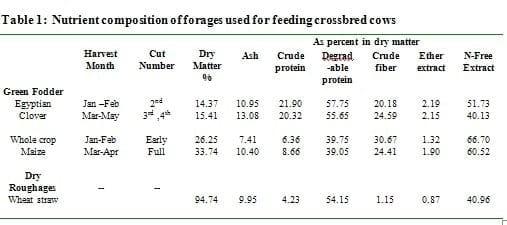
Table 2: Nutrient composition of concentrate supplements used for feeding

Table 3: Mean and standard deviation for milk composition and yield as influenced by various physiological states (Figures in parenthesis indicate the number of observations)

Table 4: Relationship of physiological and management parameters with milk yield and composition in crossbred cattle (Pearson's correlation coefficient, number of observations).
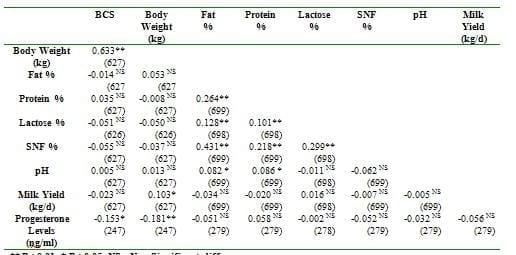
Table 5: Mean and standard deviation for milk composition and yield as influenced by green fodder and concentrates types.
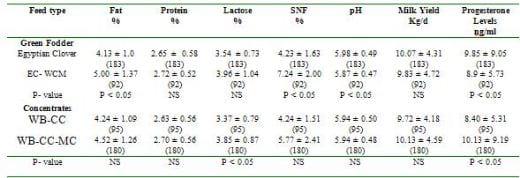
Figure 1: Changes in milk yield (▲) andbody condition score (BCS, ■) with advancing pregnancy (0= non-pregnant, 1= first trimester, 2= second trimester, 3= third trimester) in crossbred cows. The graph showed polynomial trend line for changes in the dependent variables. Equation: i) milk yield: y = -0.490x + 10.72, R2 = 0.53; ii) and BCS (y = -0.25x + 3.74, R2 = 0.59)

Figure 2: Changes in milk yield ( _ ), body condition score (BCS, ■) and milk fat (%, ▲) with the increasing lactation months in crossbred cows. Equation: i) milk yield: y = -0.50x + 11.88, R2 = 0.95; ii) BCS (y = 0.04x + 3.10, R2 = 0.74); iii) milk fat (y = 0.05x+4.20, R2 = 0.28)
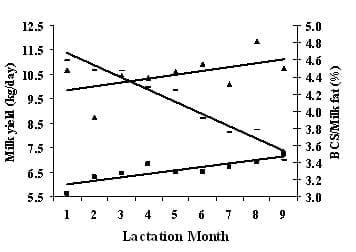
Figure 3: Changes in milk composition (fat=horizontal lines, protein=bricks, lactose=vertical and solids-not-fat=dots) with two fodder types (EC-WCM = Egyptian clover and whole crop maize). Fat and SNF (solids-not-fats) were significantly different (P < 0.05).
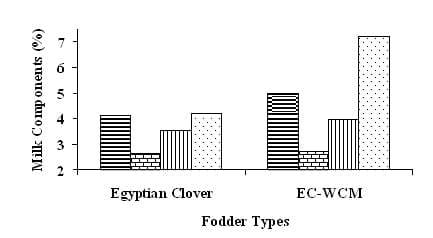
Figure 4: Changes in milk composition (fat=dots, protein=horizontal lines, lactose=vertical and Solids-Not-Fat= waves) with two combinations of concentrates; Wheat Bran, Cotton seed Cake (WB-CC) and Wheat Bran, Cotton seed Cake and Maize oil Cake (WB-CC-MC). Lactose is significantly different (P < 0.05).
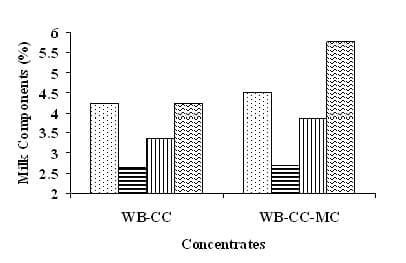
Figure 5: Changes in milk yield (▲) with the increasing age (lactation number) in crossbred cattle. Equation: i) milk yield (y = -0.33x2 + 2.96x + 5.09, R2= 0.31)
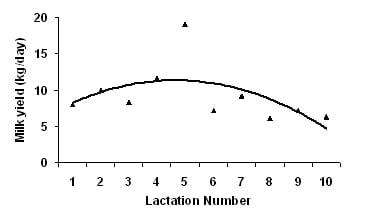
Figure 6: Changes in body condition score (BCS, ▲) at a scale of 1 to 5; and body weight (BW, ■) with the increasing age (1=first to third; 2=fourth to sixth and 3=seventh to tenth lactation) in crossbred cattle. Equation: i) BCS (y = 0.13x + 3.1, R2 = 0.99) ii) body weight (y =21.54x + 384.63, R2 = 0.99)
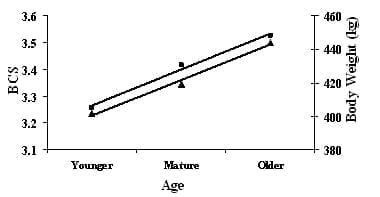
Figure 7: Changes in milk fat (●), lactose (▲) and SNF (Solids not fat, %, ) with changes in BCS (body condition score at a scale of 1 to 5 in crossbred cattle). Equation: i) Fat (y = -0.05x + 4.46); ii) SNF (y = -0.16x + 5.49) and; iii) Lactose (y = -0.13x + 3.92). Pearson's correlation coefficient for the three parameters was: -0.01, -0.055 and -0.051.
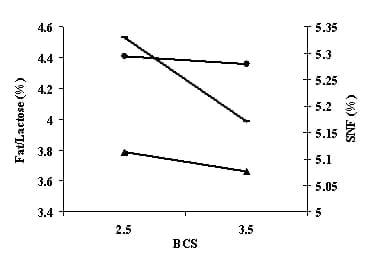
REFERNCES
Agnihotri, M. K. and V. Rajkumar. 2007. Effect of breed, parity and stage of lactation on milk composition of western region goats of India. Int. J. Dairy Sci. 2(2): 172-177.
Afzal, M., M. Anwar and M. A. Mirza. 2007. Some factors affecting milk yield and lactation length in Nili-Ravi buffaloes. Pakistan Vet. J. 27(3): 113-117.
Akers, R. M. 2002. Major advances associated with hormone and growth factor regulation of mammary growth and lactation in dairy cows. J. Dairy Sci. 89(4): 1222-1234.
AOAC. 1980. Official methods of analysis (13th ed). (Ed. H. Horwitz). Association of Official Analytical Chemists, Washington, DC.
Bachman, K. C., M. J. Hayen, D. Morse and C. J. Wilcox. 1988. Effect of pregnancy, milk yield, and somatic cell count on bovine milk fat hydrolysis. J. Dairy Sci. 71:925-931.
Bajwa, I. R., M. S. Khan, M. A. Khan and K. Z. Gondal. 2004. Environmental factors affecting milk yield and lactation length in Sahiwal cattle. Pakistan Vet. J. 24(1): 23-27.
Banerjee, G. C. 1985. A Text book of Animal Husbandry. 6th ed. Oxford and IBH Publ. New Delhi.
Bath, D. L., F. N. Dickinson, H. A. Tucker and R. D. Appleman. 1985. Dairy Cattle: Principle, Practices, Problems, Profits. 3rd ed. Lea and Febiger, Washington Square, Philadelphia.
Beam, S. W. and W. R. Butler. 1999. Effects of energy balance on follicular development and first ovulation in postpartum dairy cows. J. Reprod. Fertil. 54 (Suppl.): 411- 424.
Bell, A. W., R. Slepetis and R. A. Ehrhardt. 1995. Growth and accretion of energy and protein in the gravid uterus during late pregnancy in Holstein cows. J. Dairy Sci. 78:1954-1961.
Boisclar, Y., D. G. Grieve, J. B. Stowe, O. B. Allen and G. K. Macleod. 1986. Effect of prepartum energy, body condition and sodium bicarbonate on production of cows in early lactation. J. Dairy Sci. 69:2636.
Boros, V. 1986. Influence of the lactation period on variations in the levels of certain components of bulked goat milk. International Dairy Federation Bulletin, 202: 81-83
Broster, W. H and V. J. Broster. 1998. Body score of dairy cows. J. Dairy Res. 65:155-173.
Buckley, F., P. Dillon, S. Crosse, F. Fynn and M. Rath. 2000a. The performance of Holstein-Friesian dairy cows of high and medium genetic merit for milk production on grass based feeding systems. Livest. Prod. Sci. 64:107-119.
Buckley, F., P. Dillon, M. Rath and R. F. Veerkamp. 2000b. The relationship between genetic merit for yield and live-weight, condition score and energy balance of spring-calving Holstein-Friesian dairy cows on grass-based system of milk production. J. Dairy Sci. 83:1878-1886.
Darwash, A. O., G. E. Lamming and J. A. Woolliams. 1999. The potential for identifying heritable endocrine parameters associated with fertility in post-partum dairy cows. J. Anim. Sci. 68:333-347.
Deshpande, K. S. and P. G. Sakhare. 1984. Milk producing ability in Red Kandhari cows and its crosses. Cherion. 13: 271-273.
Dobson, H. and R. F. Smith. 2000. What is stress, and how does it affect reproduction? Anim Reprod Sci. 60-61: 743-52.
Economic Survey of Pakistan. 2008. Government of Pakistan. Economic Affairs Division. Chapter 2, Agriculture. pp:18 and pp:39.
Egbowon, B. F. 2004. Comparative evaluation of milk secretion rate and milk composition in West African Dwarf and Red Sokoto goats. M.Sc. Thesis Department of Animal Breeding and Genetics, University of Agriculture, Abeokuta, Nigeria. pp:35-47
Freetly, H. C. and C. L. Ferrell. 1998. Net flux of glucose, lactate, volatile fatty acids, and nitrogen metabolites across the portal-drained viscera and liver of pregnant ewes. J. Anim. Sci. 76:3133-3145.
Fronk, T. J., L. H. Schultz and A. R. Hardie. 1980. Effect of dry period over conditioning on subsequent metabolic disorders and performance of dairy cows. J. Dairy Sci. 63:1080.
Fulkerson, W. J. 1984. Reproduction in dairy cattle: effect of age, cow condition, production level, calving to first service interval and the 'male'. Anim. Reprod. Sci.7:305-314.
Garcia, O., K. Mahmood and T. Hemme. 2003. A review of milk production in Pakistan with particular emphasis on small scale producers. Food and Agriculture Organization, Animal Production and Health division. Pro-Poor Livestock Policy Initiative, PPLPI working paper number 3, pp: 8-25.
Garnsworthy, P. C. 1988. The effect of energy reserves at calving on performance of dairy cows. Nutrition and Lactation in the Dairy Cow. 1st ed. Butterworths, London, England. pp:157.
Grummer, R.R., D.G. Mashek and A. Hayirli. 2004. Dry matter intake and energy balance in the transition period. The Veterinary Clinics of North America: Food Animal Practice. 20: 447-470.
Gearhart, M. A., C. R. Curtis, H. N. Erb, R. D. Smith, C. J. Sniffen, L. E. Chase and M. D. Cooper. 1990. Relationship of changes in condition score to cow health in Holsteins. J. Dairy Sci. 73:3132-3140.
Grainger, C., A. W. F. Davey and C. W. Holmes. 1985. Performance of Friesian cows with high and low breeding indexes. 1. Stall feeding and grazing experiments and performance during the whole lactation. Anim. Prod. 40:379-388.
Hamburg, M. 1983. Statistical Analysis for Decision Making. 3rd ed. Harcout Brace Janovich, Publ.
Harris, B. and K.C. Bachman. 2008. Nutritional and management factors affecting solids-not-fat, acidity and freezing point of milk. Cooperative Extension Service, Institute of Food and Agricultural Sciences, University of Florida. Publication number DS25.
Hoekstra, J., A. W. Van der Lugt, J. H. J. Van der Werf and W. Ouweltjes. 1994. Genetic and phenotypic parameters for milk production and fertility in upgraded dairy cattle. Livest. Prod. Sci. 40:225-232.
Huth, F. W. 1995. Die Laktation des Rindes: Analyse, Einfluss, Korrektur. -Stuttgart: Ulmer. 289 S.
IDF. 2008. 'World Dairy Situation 2008', Bulletin of the International Dairy Federation, 430/2008, Mexico city.
Perry, R. L. I. and C. C. Stallings. 1993. Fecal consistency as related to dietary composition in lactating Holstein cows. J. Dairy Sci. 76:1074-1082.
Javed, K., 1999. Genetic and phenotypic aspects of some performance traits in a pure bred herd of Sahiwal cattle in Pakistan. Ph.D. Thesis, Univ.Agric., Faisalabad.
Lee J.Y. and I. H. Kim. 2006. Advancing parity is associated with high milk production at the cost of body condition and increased periparturient disorders in dairy herds. J. Vet. Sci. 7(2):161-166.
Malau-Aduli, B. S., I. O. Eduvie, C. A. M. Lakpini and A. E. O. Malau-Aduli. 2001. Effects of supplementation on the milk yield of Red Sokoto does. Proceedings of the 26th Annual Conference of Nigerian Society for Animal Production, ABU, Zaria, Nigeria. pp: 353-355.
Morrow, D. A. 1975. Fat cow syndrome. J. Dairy Sci. 59:1625.
Madsen, O. 1975. A comparison of some suggested measures of persistency of milk yield in dairy cows. Anim. Prod. 20:191-197.
Moate, P. J. and D. J. Harris. 1983. A survey to determine the influence of cow condition score, calving to service interval, age and milk yield on cow fertility. Dairy Production Report. Dairy Research Institute, Ellinbank, Australia. pp:106-108.
Neville, M. C., J.A. Moton and S. Umemora. 2001. Lactogenesis: the transition between pregnancy and lactation. Pediatrics Clinics of North America. 48: 35-52.
Overton, T. R. and M. R.Waldron. 2004. Nutritional management of transition dairy cows: strategies to optimize metabolic health. J. Dairy Sci. 87: (E:Suppl.) E105-E119.
Pal, U. K., V. K. Saxena, M. K. Agnihotri and R. Roy. 1996. Effect of season, parity and stage of lactation on the composition of Jamunapari goat's milk. Int. J. Anim. Sci. 11: 245-248.
Pavic, V., N. Antunac, B. Mioc, A. Ivankovic and J. L. Havranek. 2002. Influence of stage of lactation on the chemical composition and physical properties of sheep milk. Czech J. Anim. Sci. 47 (2): 80-84.
Pedron, 0., F. Cheli, E. Senatore, D. Baroli and R. Rizzi. 1993. Effect of body condition score at calving on performance, some blood parameters, and milk fatty acid composition in dairy cows. J. Dairy Sci. 76: 2528-2535.
Peters, A. R. and P. J. H. Ball. 1987. Reproduction in cattle. Butterworths, London. pp: 167-168.
Pryce, J. E. and R. F. Veerkamp. 2001. The incorporation of fertility indices in genetic improvement programmes. BSAS occasional meeting 'Fertility in high producing dairy cow', 10-22 September 1999, Galway. BSAS publication 26 (I):237-249.
Qureshi, M. S., J. M. Khan, I. H. Khan, R. A. Chaudhry, K. Ashraf and B.D. Khan. 2001. Improvement in economic traits of local cattle through crossbreeding with Holstein Friesian semen. Pakistan Vet. J. 22(1): 21-26.
Qureshi, M. S., G. Habib, H. A. Samad, M. M. Siddiqui, N. Ahmad and M. Syed. 2002. Reproduction-nutrition relationship in dairy buffaloes. I. Effect of intake of protein, energy and blood metabolites level. Asian-Aust. J. Anim.Sci. 15(3): 330-339.
Qureshi, M. S., S. Khan and N. Ahmad. 2007. Pregnancy depresses milk yield in dairy buffaloes. Ital. J. Anim. Sci. 6: 1290-1293.
Qureshi, M.S. and N.Ahmad 2008. Interaction among calf suckling, use of oxytocin, milk production and reproduction in dairy buffaloes. Anim. Reprod. Sci. 106: 380-392.
Raheja, K. L., E. B. Burnside, and L. R. Schaeffer. 1989. Relationship between fertility and production in Holstein dairy cattle in different lactations. J. Dairy Sci. 72:2670-2678.
Rollinson, D. H. L. 1978. Livestock breeding policies in Pakistan. FAO, Rome, Italy. pp:18.
Royal, M. D., A. O. Darwash, A. P. F. Flint, R. Webb, J. A. Woolliams and G. E. Lamming. 2000. Declining fertility in dairy cattle: changes in traditional and endocrine parameters of fertility. J. Anim. Sci. 70:487-501.
Sardar, M. J. U., M. Shamsuddin, M. M. U. Bhuiyan and M. A. Rahman, 1997. Individual cow as determination of the fertility and productivity in mini dairy farms. Bangladesh Vet. J. 31: 91-98.
Sarwar, M., M. A. Khan and Z. Iqbal. 2002. Feed resources for livestock in Pakistan. Int. J. Agri. Biol. 4:186-192.
Sarzamin, K., M. S. Qureshi, N. Ahmad, M. Amjed, F. R. Durrani and M.Younas. 2008. Effect of pregnancy on Lactation Milk Value in Dairy Buffalo. Asian-Aust. J. Anim. Sci. 21(4): 523-531.
Shah, M., M. S. Qureshi and M. Tahir. 2009. Effects of different feed combinations on glucose contents in milk and blood of crossbred cows and buffaloes. MSc (Hons) thesis, Department of Livestock management, NWFP Agricultural university, Peshawar.
SPSS, Inc. 1999. SPSS Regression Models 10.0. Chicago.
Syed, M., M. Ali and N. Ahmad. 1994. Production efficiency of crossbred cattle at Livestock Research and Development Farm, Surezai, Peshawar. MSc (Hons) thesis, Department of Livestock management, NWFP Agricultural university, Peshawar.
Tahir, M., M. R. Qureshi and W. Ahmad. 1989. Some of the environmental factors influencing milk yield in Sahiwal cows. Pakistan Vet. J. 9: 173-175.
Veerkamp, R. F. and S. Brotherstone. 1997. Genetic correlations between linear type traits, feed intake, live weight and condition score in Holstein Friesian dairy cattle. J. Anim. Sci. 64:385-392.
Veerkamp, R. F., G. Simm and J. D. Oldham. 1994. Effects of interaction between genotype and feeding system on milk production, feed intake, efficiency and body tissue mobilisation in dairy cows. Livest. Prod. Sci. 39:229-241.
Villa-Godoy, A., T. L. Hughes, R. S. Emery, L. T. Chapin and R. L. Fogwel. 1988. Associations between energy balance and luteal function in lactating dairy cows. J. Dairy Sci. 71:1063-1072.
Waltner, S. S., J. P. McNamara and J. K. Hillers. 1993. Relationships of body condition score to production variables in high producing Holstein dairy cattle. J. Dairy Sci. 76:3410-3419.
Wildman, E. E., G. M. Jones, P. E. Wagner, R. L. Bowman, H. F. Troutt Jr and T. N. Lesch. 1982. A dairy cow body condition scoring system and its relationship to selected production characteristics. J. Dairy Sci. 65:495-501.
Figure 3: Changes in milk composition (fat=horizontal lines, protein=bricks, lactose=vertical and solids-not-fat=dots) with two fodder types (EC-WCM = Egyptian clover and whole crop maize). Fat and SNF (solids-not-fats) were significantly different (P < 0.05).
Related topics:
Authors:
Livestock Management Department
Recommend
Comment
Share
Livestock Management Department
29 de noviembre de 2009
Comments of the honorable member are welcome. The study reports an applied work under tropical conditions without any intervention. Age of the animals, lactation stage, pregnancy status and feed types were selected as independent variables, related to management. Composition of milk is regulated by the hypothalamus through various hormones and regulating factors. This phenomenon changes with maturity of the animal associated with the increasing age. Postpartum changes in the physiological status of the animal affect the nutrients composition of milk by changing hormonal levels, in line with the reproductive cyclicity, nutrient supply and milk yield. Nutrient supply was not the focus of this study, so only feed types were selected because they influence the availability of substrates to the blood circulation, which are utilized for milk synthesis or stored as adipose tissues. The four management parameters selected for this study may be used as variable in the farm management practices.
Recommend
Reply

21 de enero de 2010
This article is really very interesting.Although things are not new but still giving importance to these aspects is really important.Thanks every 1 for sharing their knowledge.and I truely agree with Syed Hassan Raza sb.
Regards,
Dr.Sana Ahmad
Recommend
Reply
Sweetwater International, Inc.
18 de diciembre de 2009
Very informatic article. thank you Hafiz Sb and Hassan Raza Sb for addtional comments and remarks
Regards
Subhani
Recommend
Reply

18 de diciembre de 2009
Dear Hafiz sb
To set feeding,breeding and management tips is not easy job unlless you visit farm yourself and have complte information of management system being used at that farm. Anyhow two things breeding plan and management plans are very important to run a crossbred farm. The management would remain changing with change in environment and physiological conditions of animals. Of course with change in locality the management practices will also changed. To improve the ptoductiivity of farm on commercial grounds the wet average and herd average need to be monitored very carefully after setting production goals.
Recommend
Reply
9 de diciembre de 2009
The experiment is a wonderful try by Dr Qureshi. Such trials must continue in different locations and by different scientists especially when we talk of cross bred animals as in Pakistan there is no specific policy about cross breeding. Many new things come out when different scientists try the same thing in different locations in their own way.
Does not make any difference if somebody is not benifitted but I am the one who has got my mind clear about factors affecting milk composition.
Syed Hassan Raza is well respected person in the field of livestock management and I will request him to add the management tips based on his vast knowledge and experiences to make the article more beautiful and comprehensive in the interest of livestock business and community.
I again congratulate Dr Qureshi for his fruitful efforts
Recommend
Reply

25 de noviembre de 2009
Although article is interesting but nothing is new. The study confirms already confirmed facts.
The effect of management was not discussed but it is mentioned in title. All the animals are kept under standard management conditions (mentioned by authors).
Instead of mentioning feed stuff the nutrients supply will be more meaningful.
The concentrate feeding should be adjusted according to the energy secreated in the milk and it is very imported for the high yielding animals.
The effect of tempereture also needs to be addressed as it affects the water and feed intake. The high water intake will definitely reduce the lag time and nutrients absorption and affect milk yield.
Recommend
Reply

Would you like to discuss another topic? Create a new post to engage with experts in the community.
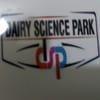


.jpg&w=3840&q=75)

.jpg&w=3840&q=75)




